
Three Yet One by Parallel Projects
London Design Festival 09: Henny van Nistelrooy and Oscar Diaz of Parallel Projects presented an exhibition in London last week examining how the media affects our perception of design.
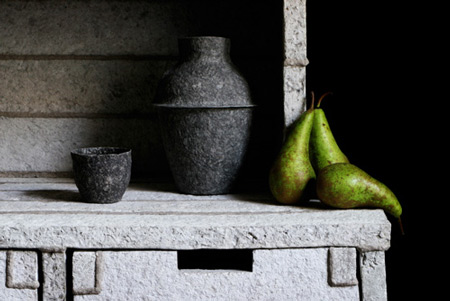
Called Three Yet One, the exhibition in South Kensington showcased specially-designed objects by twelve designers
Above: Paper Pulp n. (by Debbie Wijskamp)
A totemic white cabinet consisting of a number of stacked oblong boxes, some with drawers, some empty. Looking at first glance like the polystyrene containers used to pack fish, with their inch-thick walls, each box component is in fact moulded from paper pulp and assembled using simple box-jointing techniques borrowed from woodwork.
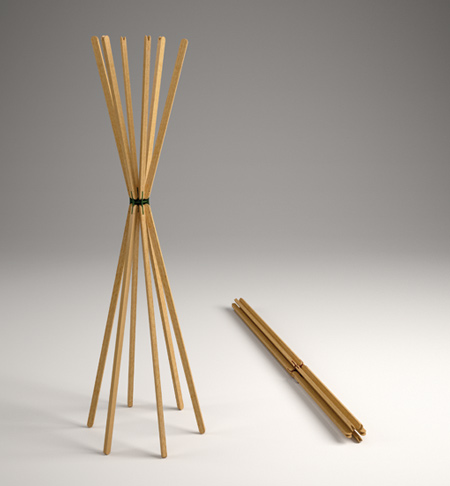
Each exhibit included the object itself, a piece of descriptive text about it by designer and writer Tim Parsons, and a carefully-styled photograph by photographer Emma Wieslander.
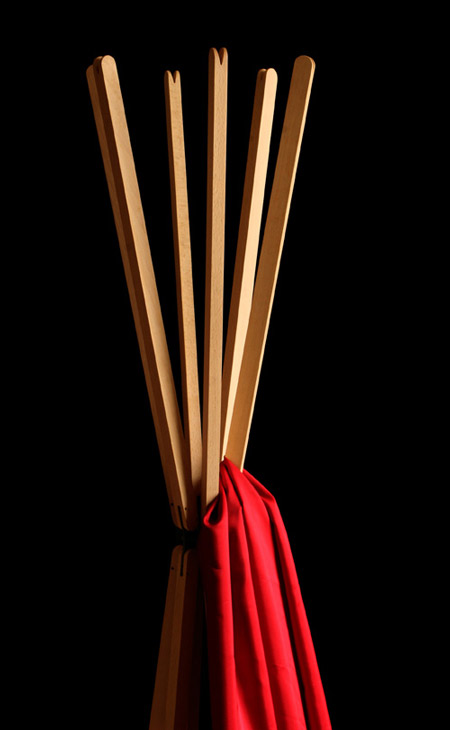
A selection of pieces are shown here in all three formats with Tim Parson's text as captions.
Above: Coat stand n. (by Luka Stepan)
A folding [insert wood type, i.e. “ash”] coat stand that transforms from a single [insert length, i.e. 2m] long beam of wood into two tripods joined at their points with their opposing legs facing away from each other. Each of the three legs of the upward facing tripod can be split longitudinally and hinged apart, their top ends providing six equally spaced hooks.

Above and below: Raw n. (by Jochem De Wit)
A series of domestic vessels in different materials that have about them the quality of artefacts recovered from an archaeological dig.

All have a heavy weight – both visual and material – that evoke an earlier, less-refined civilization. Although the drinking vessels step in at their waist to stack, their thickset walls and rough finishes give them crudeness challenging in these days of manufactured perfection.
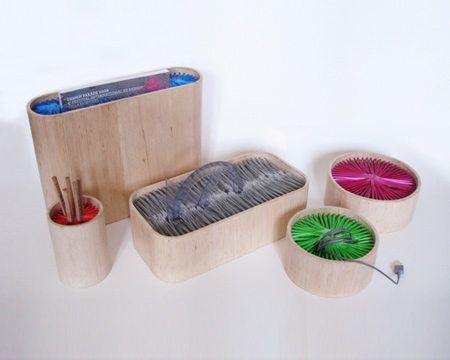
Above and below: Boites n. (by Atelier BL119)
A set of wooden boxes, circular, elliptical or oblong in section, with open tops. Inside each box, bristles fill the void, encroaching from the walls to the centre.
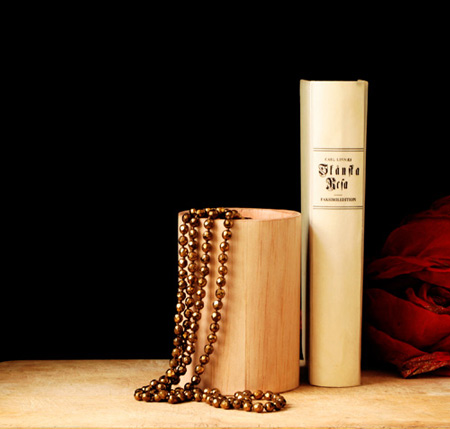
This thicket of colourful strands can trap any manner of personal possessions. These might be either planted so as to be fully concealed, partly revealed or can be sat on top of the bristles to be framed by the wooden rim.

Above and below: Table n. (by David Sutton)
A table consisting of a pair of two-legged metal trestles and a birch ply top.
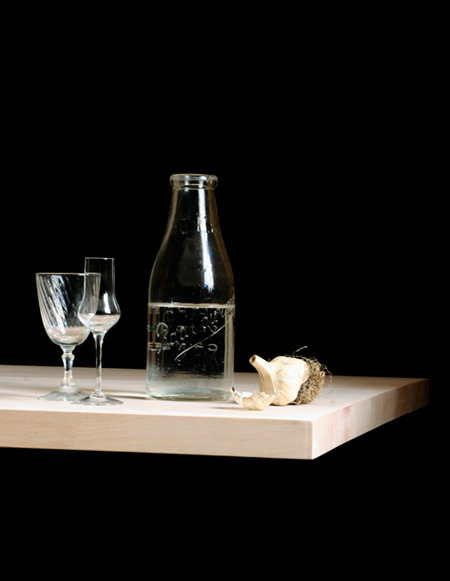
The trestles, fabricated from sheet steel, have a plate (that screws into the underside of the table top) in the shape of a hexagon made irregular by being squashed, bringing two of its parallel sides closer together and leaving two sharper corners. Projecting down from these corners run two ‘L’ section folded steel legs that meet the floor in a firm stance.
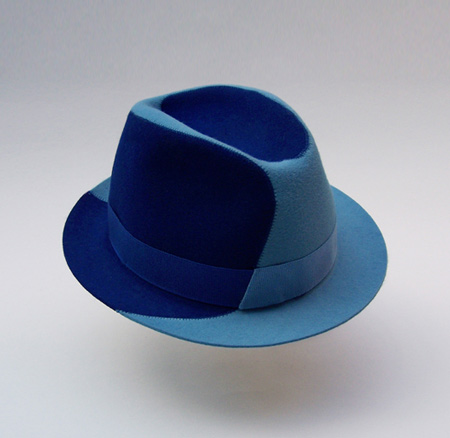
Above and below: Cappello della Luce n. (by Henny van Nistelrooy)
A green Italian fur felt trilby hat with the areas of its surface that would be cast into shadow by a strong spotlight made in material of a darker tone. As if forever caught amid the shooting of a film noir, the right hand side of the crown and the left hand side of its crease are picked out in olive-green felt with the remaining areas knocked back into a dark tone of the same colour.
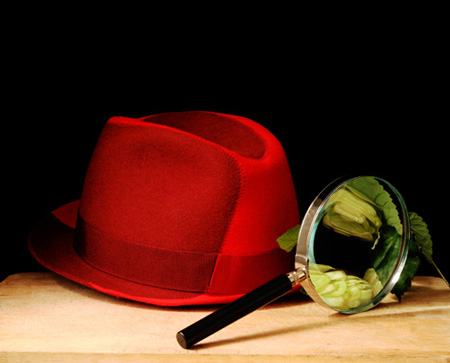
Product photos are by Max Kropitz.
Here's some information from Parallel Projects:
--
Three Yet One
How do media affect the perception of an object?
“THREE YET ONE” is a design exhibition that explores the role different media play in shaping our understanding and perception of products. Curated by Parallel Projects for the London Design Festival as part of the Brompton Design District, it showcases the work of 12 emergent designers specifically commissioned for this exhibition.
“Three yet one” takes as starting point Joseph Kosuth “One and Three Chairs” art piece, but rather that presenting an object from the same point of view with different media, “Three yet one” interest is to widen the understanding of the object by showing different points of view. Taking a cross-disciplinary approach Parallel Projects have invited a photographer and a writer to describe/illustrate the products from their personal point of view.
The intention is to avoid the object-centrism and formalism often associated with design exhibitions and place design within a wider cultural frame. This multi-layered representation of the products will in turn stimulate the public to create their own interpretation. By showcasing 3 different points of view “THREE YET ONE” offers new perspectives into contemporary notions of design.
The exhibition is taking place from 23 – 27 September at 5 Cromwell Place in the heart of South Kensington.
Participating designers:
Atelier BL119 (Grégory Blain & Hervé Dixneuf)
Bas Kools & Yohanna My
David Sutton
David Weatherhead
Debbie Wijskamp
Henny van Nistelrooy
Inca Starzinsky
Jochem de Wit
Jonathan Legge
Luka Stepan
Zaven (Marco Zavagno & Enrica Cavarzan)
Oscar Diaz
EXHIBITION CREDITS
Curated and Designed by Parallel Projects ( www.parallel-projects.com)
Projects texts by Tim Parsons ( www.timparsons.info)
Photography by Emma Wieslander (www.emmawieslander.com)
Catalogue by Julia (www.about-julia.com)
Exhibition Pictures by Mark Kr
About Parallel Projects
Parallel Projects create experiences through design exhibitions.
Founded by Oscar Diaz and Henny van Nistelrooy, their holistic approach include curating, art direction and exhibition design.
Since their collaboration started they have curated “Changing dimensions” for the LDF 2008, “Airmail” at GOODD gallery in Glasgow and now “Three yet one” for this year LDF.
Three Yet One is supported by South Kensington Estates and is part of the Brompton Design District 2009 programme. The Brompton Design District, initiated by South Kensington Estates and local organisations, encourages the presence of new design in an area renowned for its important design shops as well as its historic links with design and education since the founding of the Victoria and Albert Museum and Royal College of Art 150 year